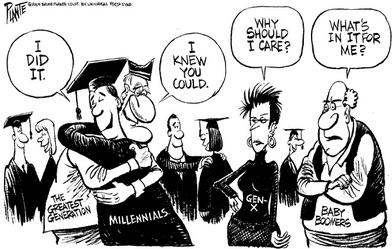Multi-Generational

An underlying concept of the healthcare workforce is the overlap of generations. As healthcare prepares for retirement of one generation, another enters the profession. In a study on the challenges of multi generations working together, Dickerson (2010) points out that often we have no insight into other generation’s viewpoint. She notes that individuals are focused on wanting others to be “like us” and when they aren’t, conflict arises (Dickerson, 2010). Each generation possess inherently different characteristics based upon their own socialization and past experiences. The following passage offers insight into various generations as well as how these characteristics can impact our current workforce.
Baby Boomer (1940-1960)
People of this generation pride themselves on having a better life than their parents (Dickerson, 2010). They are strongly roots in breaking previous traditions. This era saw the largest amount of divorce and the definition of traditional family changed dramatically (Dickerson, 2010). These children were labeled “latch key” and had to become self-sufficient and independent at a very young age.
Generation X (1965-1980)
These children had parents who worked long hours and many jobs to support their families (Dickerson, 2010). While the parents worked hard to support their families, the children were alone, without family support and had no real sense of community (Dickerson, 2010). This generation is focused on finding balance in their lives as they do not wish to repeat history. Technology began to emerge in this generation and they are considered to be technology competent (Dickerson, 2010).
Generation Y – Millennials (1981-2000)
These are the newest recruits to enter the workforce. They have grown up on technology and are often more comfortable in a virtual world then interacting in a real one (Dickerson, 2010). Their parents (Gen X’ers) grew up without family support so to make up for this; they are helicopter parents to Millenials. Gen Xer parents provide strict routines, often settle all of their children’s conflicts, and highly schedule Millennial free time activities. This group experienced travesties like Columbine and cyerstalkers and as a result has a high degree of mistrust(Dickerson, 2010). As a result, gen Y population have difficulty communicating, handling conflict and expect to have support at all times.
Impact on the Workforce
Understanding each generation is one level, trying to incorporate all into a working environment, is a completely different challenge. The following are examples of what each generation looks like in a working environment:
Baby Boomers
Largely from a diploma educational background, this generation is extremely committed to nursing as a profession and hold high patient care standards (Dickerson, 2010). They tend to be workplace leaders and strong change agents.
Generation X
This generation is self-sufficient, independent and not big on team activities (Dickerson, 2010). They put themselves before the organization and often ask “what’s in it for me”. They have a strong sense of what needs to be done, can multi task, prioritize and are technology savvy (Dickerson, 2010).
Generation Y
Having grown up on technology, this group will run to a computer to Google a question before they would take the time to ask a senior member. They grew up in an environment where the playing field was level and expect this in their work environment (Dickerson, 2010). They are used to multi-cultural environments and have an enormous bank of energy.
Baby Boomer (1940-1960)
People of this generation pride themselves on having a better life than their parents (Dickerson, 2010). They are strongly roots in breaking previous traditions. This era saw the largest amount of divorce and the definition of traditional family changed dramatically (Dickerson, 2010). These children were labeled “latch key” and had to become self-sufficient and independent at a very young age.
Generation X (1965-1980)
These children had parents who worked long hours and many jobs to support their families (Dickerson, 2010). While the parents worked hard to support their families, the children were alone, without family support and had no real sense of community (Dickerson, 2010). This generation is focused on finding balance in their lives as they do not wish to repeat history. Technology began to emerge in this generation and they are considered to be technology competent (Dickerson, 2010).
Generation Y – Millennials (1981-2000)
These are the newest recruits to enter the workforce. They have grown up on technology and are often more comfortable in a virtual world then interacting in a real one (Dickerson, 2010). Their parents (Gen X’ers) grew up without family support so to make up for this; they are helicopter parents to Millenials. Gen Xer parents provide strict routines, often settle all of their children’s conflicts, and highly schedule Millennial free time activities. This group experienced travesties like Columbine and cyerstalkers and as a result has a high degree of mistrust(Dickerson, 2010). As a result, gen Y population have difficulty communicating, handling conflict and expect to have support at all times.
Impact on the Workforce
Understanding each generation is one level, trying to incorporate all into a working environment, is a completely different challenge. The following are examples of what each generation looks like in a working environment:
Baby Boomers
Largely from a diploma educational background, this generation is extremely committed to nursing as a profession and hold high patient care standards (Dickerson, 2010). They tend to be workplace leaders and strong change agents.
Generation X
This generation is self-sufficient, independent and not big on team activities (Dickerson, 2010). They put themselves before the organization and often ask “what’s in it for me”. They have a strong sense of what needs to be done, can multi task, prioritize and are technology savvy (Dickerson, 2010).
Generation Y
Having grown up on technology, this group will run to a computer to Google a question before they would take the time to ask a senior member. They grew up in an environment where the playing field was level and expect this in their work environment (Dickerson, 2010). They are used to multi-cultural environments and have an enormous bank of energy.
